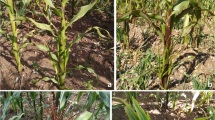Abstract
Mexico is considered to be one of the centers of origin of grain amaranth species. Recently, plants with abnormal anatomical features were observed in experimental fields established in Central Mexico. The most noticeable symptoms, which consisted of excessive stem and bud proliferation, mosaics and unusual coloration, suggested that they might be phytoplasma-induced disorders. Thus, different accessions of grain amaranth (Amaranthus hypochondriacus and A. cruentus) plants were subjected to polymerase chain reaction (PCR) analysis specifically designed to detect these pathogens. Two universal phytoplasma-specific primer pairs were tested in a nested PCR assay, with primer pair P1/tint (followed by primer pair R16F2/R16R2). Further DNA sequencing analysis of the resulting amplicons indicated that these phytoplasmas may be related to others already affecting important agricultural crops in Mexico, such as soybean. Data are presented that disclose the etiology of these syndromes by the use of molecular techniques. To the best of our knowledge, this finding constitutes the first report of a phytoplasma-related disease in grain amaranth.

Similar content being viewed by others
References
Altschul, S. F., Madden, T. L., Schäffer, A. A., Zhang, J., Zhang, Z., Miller, W., et al. (1997). Gapped blast and psi-blast: a new generation of protein database search programs. Nucleic Acids Research, 25, 3389–3402.
Andrasofszky, E., Szocs, Z., Fekete, S., & Jelenits, K. (1998). Evaluation of the nutritional value of the amaranth plant. I. Raw and heat-treated grain tested in experiments on growing rats. Acta Veterinaria Hungarica, 46, 47–59.
Firrao, G. (2004). ‘Candidatus phytoplasma’, a taxon for the wall-less, non-helical prokaryotes that colonize plant phloem and insects. International Journal of Systematic and Evolutionary Microbiology, 54, 1243–1255.
Lee, I. M. (1998). Phytoplasma: ecology and genomic diversity. Phytopathology, 88, 1359–1366.
Lee, I. M., Davis, R. E., & Gundersen-Rindal, D. E. (2000). Phytoplasma: phytopathogenic mollicutes. Annual Review of Microbiology, 54, 221–255.
Leyva-López, N. E., Ochoa-Sánchez, J. C., Leal-Klevezas, D. S., & Martínez-Soriano, J. P. (2002). Multiple phytoplasmas associated with potato diseases in Mexico. Canadian Journal of Microbiology, 48, 1062–1068.
Weintraub, P. G., & Beanland, L. (2006). Insect vectors of phytoplasmas. Annual Review of Entomology, 51, 91–111.
Zhang, Y. P., Uyemoto, J. K., & Kirkpatrick, B. C. (1998). A small-scale procedure for extracting nucleic acids from woody plants infected with various phytopathogens for PCR assay. Journal of Virological Methods, 71, 45–50.
Acknowledgments
We wish to thank Consejo de Ciencia y Tecnología del Estado de Guanajuato (CONCYTEG) for providing financial support (code 08-03-k662-076). In addition, FIPC and KAP are supported by funds from CONACYT, Mexico. We appreciate the technical support of Verónica Sánchez-Briseño.
Author information
Authors and Affiliations
Corresponding author
Rights and permissions
About this article
Cite this article
Carlos Ochoa-Sánchez, J., Isela Parra-Cota, F., Aviña-Padilla, K. et al. Amaranthus spp.: a new host of “Candidatus Phytoplasma aurantifolia”. Phytoparasitica 37, 381–384 (2009). https://doi.org/10.1007/s12600-009-0040-9
Received:
Accepted:
Published:
Issue Date:
DOI: https://doi.org/10.1007/s12600-009-0040-9




